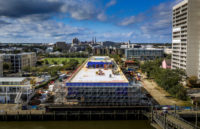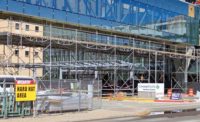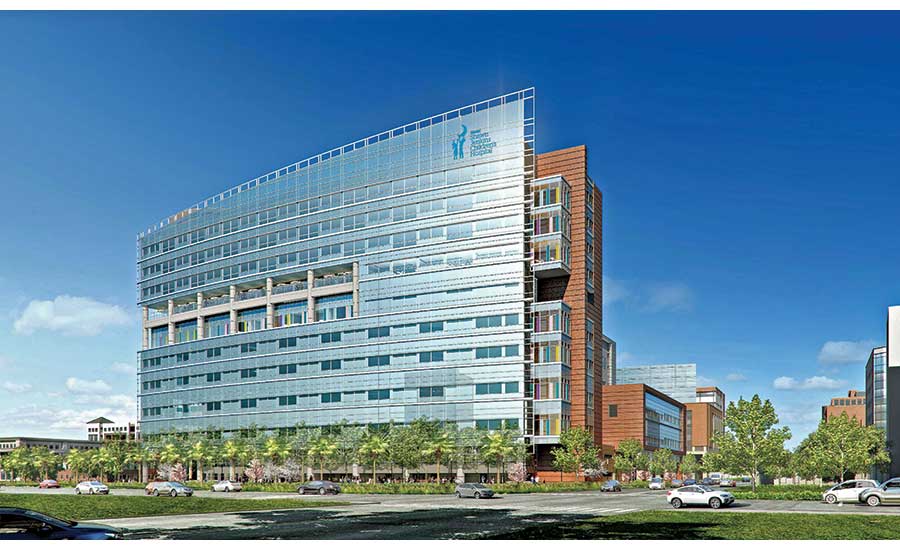Crafty Execution Delivers Charleston Hospital on Tight Site

One of the contractor's most recent projects is the Medical University of South Carolina’s new children’s hospital in Charleston.
PHOTO COURTESY ROBINS & MORTON

The hospital’s exterior is comprised of brick, precast, stucco, metal panels, punch windows and curtain wall designed to withstand 157- mph winds.
PHOTO COURTESY ROBINS & MORTON

MUSC’s 11-story tower will include 260 patient beds.
PHOTO COURTESY ROBINS & MORTON

Robins & Morton workers prepare for a project-wide meeting.
PHOTO BY BRITTANY TORBETT, COURTESY ROBINS & MORTON

Contractors say converting the flow of steel erection and concrete pours into 4D eliminated the potential for sequencing errors.
PHOTO COURTESY ROBINS & MORTON

The contractor used a nearby warehouse to perform prefabrication work for sheet metal, ductwork, piping and large electrical sections.
IMAGE COURTESY ROBINS & MORTON

The project was designed by the team of McMillan Pazdan Smith and Perkins+Will.
IMAGE COURTESY ROBINS & MORTON

Robins & Morton utilized lean principles to deliver the project. Here, workers gather for a daily stand-up meeting.
PHOTO BY BRITTANY TORBETT, COURTESY ROBINS & MORTON








Any major construction project in downtown Charleston, S.C., is likely to pose a challenge, whether it’s the close proximity of existing buildings that sharply constrains work and staging areas or the coastal city’s poor soils and high water table that usually necessitates intricate foundation systems.
Had those been the only significant issues facing the team building the $255-million Shawn Jenkins Children’s Hospital and Women’s Pavilion at the Medical University of South Carolina, the project might well be considered relatively routine. But long before the construction management team of Robins & Morton and Cumming and Brownstone Construction Group began crafting a strategy to turn the 635,000-sq-ft complex from concept into reality, it was clear that even by Charleston standards, this would be no ordinary construction project.
Although MUSC’s existing 350,000-sq-ft children’s hospital had been built less than three decades earlier, it lacked the space and infrastructure necessary for modern, family-oriented approaches to pediatric care. The design team of McMillan Pazdan Smith and Perkins+Will drew on extensive input from MUSC’s clinical staff to ensure wise use of space, coalescing those ideas into an 11-story tower with 260 patient beds, a six-story diagnostic and treatment building, facilities for neonatal and pediatric intensive care, a large labor and delivery unit, a special care nursery and specialized children’s emergency services.
“It was important to keep our foot on the gas and get bid documents out before other projects sucked up labor.”
– John Sion, MUSC Health
Yet throughout, the needs of patients and family came first, says Perkins+Will managing principal Jeff Tyner. For example, each floor’s private family lounge is situated to provide the best possible views of the city. The roof, designed to support Coast Guard helicopters in the event of an emergency evacuation, is fitted with active play areas for children as well as separate casual areas for families and staff members.
The exterior design is crafted for both aesthetics and resiliency. Complementing the brick, precast, stucco, metal panels and punch windows is a curtain wall designed to withstand 157-mph winds.
Incorporating the hospital’s amenities and program elements while staying within a tight budget was a constant challenge, Tyner says, “and the only way we got through it was by teamwork.”
Tyner recalls several “intense” design meetings, including a two-day session focused on the hospital’s lighting systems. By meeting’s end, the project team had reduced that part of the budget to $3.86 per sq ft—nearly half the conventional lighting budget for a facility of that type—and less than the original target.
“We saved the hospital $1.5 million while also achieving all the design goals,” Tyner says, “but it took a lot of work.
John Sion, director of major construction projects for MUSC Health, adds that the project team had to be cognizant of the calendar. A new Volvo manufacturing plant and other major projects scheduled to get underway around the hospital’s scheduled summer 2016 construction start date would put pressure on South Carolina’s already limited craft labor resources.
“It was important to keep our foot on the gas and get bid documents out before other projects sucked up labor,” Sion says.
Clearing the way … and the air
Having signed on as construction managers at-risk a month after the architects, the Robins & Morton/Cumming Brownstone team and its major subs served in a design-assist role while also making preparations to clear the three-acre site by demolishing a four-story, 170,000-sq-ft building that formerly served as Charleston Memorial Hospital. With three other separately owned medical facilities adjacent to the site, all demolition work had to be planned and executed to minimize noise, dust and other hazards.
Robins & Morton worked with the adjacent hospitals to develop an infection control risk assessment (ICRA) that included daily air quality monitoring at 14 locations to ensure dust created by demolition work remained within acceptable levels, protecting staff, visitors and patients with suppressed immune systems.
The demolition phase also offered the project team an early opportunity to apply 4D modeling, which Robins & Morton project manager Steve Wiley says would become a valuable tool for identifying safety and scheduling issues during subsequent phases. While converting as-built documents marked up for demolition sequencing into a 4D model, the project team identified critical information gaps regarding the order in which specific elements such as walls and stairwells were to be removed.
“We also shared the model with operators to help them plan and safely carry out their work,” Wiley adds.
Due to difficult soil conditions, Robins & Morton installed a perimeter subsurface dewatering system to help compensate for a water table located just a few feet below the surface. Excavation for the foundation system then began, with the site lowered 6 ft to the approximate height of caps that would top approximately 1,300 precast concrete piles. Crushed concrete left over from the demolished building was installed around the pile grid to provide a stable working surface for driving the piles approximately 95 ft to a subterranean level of solid clay.
That work had to wait, however, as Hurricane Matthew arrived in early October 2016. The first of five named tropical storms that would affect the project, Matthew inundated Charleston with a 6-ft storm surge, flooding the MUSC hospital site with an estimated 10 million gallons of water.
Wiley says the dewatering system was up to the task of draining the temporary lake.
“We got back to work in four days,” he says. “Other construction sites in Charleston were stalled for as much as two weeks.”
Sion says the ability to get both floodwater and structural elements out of the ground quickly was essential to meeting the hospital’s 30-month completion schedule, as was the early release of contracts for chillers and other major building system components.
“Having chilled water lines in place before the building was ready would allow us to seamlessly move to interior work when the shell was ready,” he explains. “Otherwise, Charleston’s humidity would have made hanging drywall much more difficult.”
Timing was equally critical on a day-to-day basis, as limited laydown space required daily materials deliveries from a leased 80,000-sq-ft high-bay warehouse located 15 minutes away. Though most supplies could be transported during the evening, delivery of the piles, steel and curtain wall components had to be directly coordinated with the hospitals to minimize disruptions with shift changes and patient traffic.
In addition, the warehouse served as a center for the project’s prefabrication work on sheet metal, ductwork, piping and large electrical sections.
“We would send over components in advance of each day’s schedule, which helped with mitigating traffic issues and space usage at the site,” says Wiley. Along with facilitating a more efficient work flow and better relations with the new hospital’s neighbors, Robins & Morton estimates that the logistics strategy reduced the project’s transportation costs by 35%.
The use of 4D modeling likewise became instrumental in identifying potential constructibility issues that might otherwise have been missed using a traditional 2D-based approach. The company says converting the flow of steel erection and concrete pours into 4D eliminated the potential for sequencing errors, allowing the team to “proofread” its schedule. The technology also helped identify deliveries scheduled to take place outside the normal time periods so that the team could get a head start on helping surrounding businesses mitigate potential effects on their operations.
Robins & Morton also credits the scheduling approach for enhancing safety. As of the end of December, the total recordable incidence rate for the project was 1.82, with a total lost-time incidence rate of 0.20.
Yet even with the attention to planning and timing, some potential snags were overlooked. What originally was considered a relatively simple reduction in the curtain-wall system depth, from 10 in. to 7.5 in., during the value engineering stage eventually forced the team to fine-tune steel connections in the field.
Wiley admits that the change should’ve been addressed at the time, but adds, “You don’t always see every issue that might arise.”
More weather woes
Otherwise, Wiley says the project’s progress has been relatively incident-free, which he credits to the team’s up-front planning and modeling tools. Weather, always a wild card, did play havoc with the schedule, with demobilization/remobilization plans initiated each time a new system showed signs of threatening the Southeast U.S.
That included September 2018’s Hurricane Florence, which would dump record amounts of rainfall across the Carolinas. Although the worst of the storm’s effects were well north of Charleston, work at MUSC was idled for nearly two weeks, first by a state-imposed evacuation order, then manpower shortages as many workers were from areas hit hard by flooding.
Yet with each new weather event, Sion says the Robins & Morton was team “was ready with a great plan to prepare the site, minimize damage and get the project back up to speed relatively quickly.”
The new year will see completion of interior finishes and exterior skin details, leading to the hospital’s scheduled handover to MUSC in mid-April, and its eventual certification as LEED Silver. By October, the new hospital will welcome its first patients. And Sion says they’ll be pleased with what they find.
“We’re particularly pleased at how the hospitals address the needs of families who face so many other pressures during what can be a very stressful time,” he says. “It’s a special facility.”











